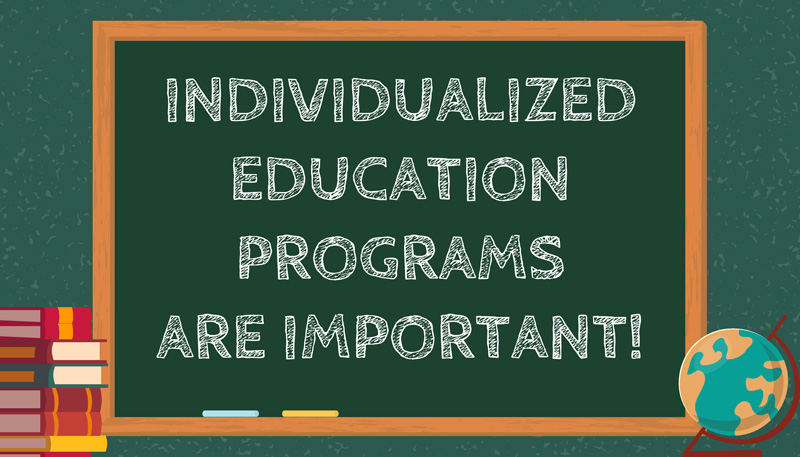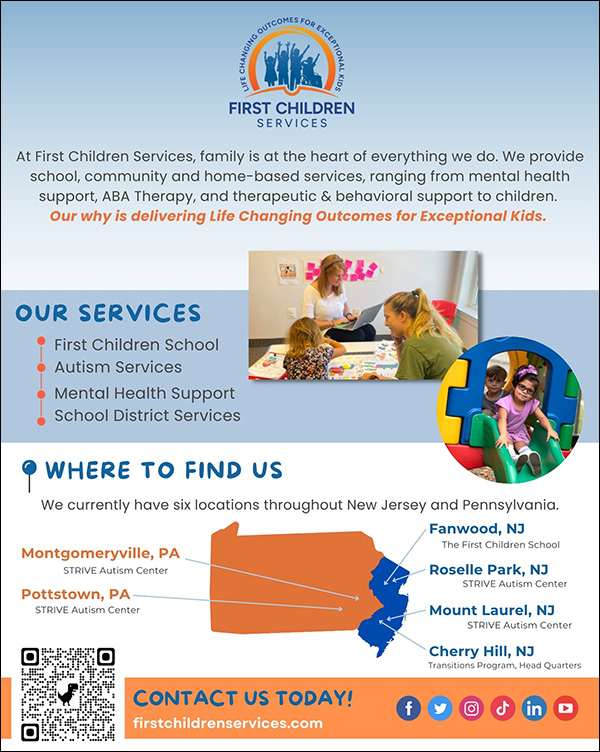To address the inequity of limiting special needs children from obtaining an appropriate public education, the Individualized Education Program (IEP) was implemented in 1975 across the United States school systems. The IEP is an educational road map for children with disabilities. It is required by federal law under the Individuals with Disabilities Education Act (IDEA) and is a regularly updated document that outlines specific goals and milestones for students to achieve based on academic need. IEPs are created by a team composed of teachers, parents, school administrators, other school staff such as psychologists, and sometimes students themselves. Schools will evaluate a student to determine whether they qualify for an IEP or 504 plan.

All students receiving special education services have an IEP. Students with IEPs can have autism, intellectual disabilities, orthopedic impairments, brain injuries, deafness, vision impairments, speech or language impairments, or other disabilities that require specialized help with school. IEPs are developed, revised, and reviewed during annual review meetings in conjunction with a representative from the sending district and parents develop the working plan for delivery of special education services. IEPs include the following components:
- the student’s present level of academic achievement and functional performance
- statement of measurable and annual goals
- description of student’s progress towards meeting the goals
- participation with non-disabled peers
- accommodations needed to measure academic achievement and functional performance
- projected date for the beginning of services and anticipated frequency, location, and duration, additional considerations (behavioral, communication, visual)
- transition services when appropriate (for students aged 14 and up)
Special Education services outlined in IEPs can include: occupational, speech or behavioral therapy; one-on-one help from a tutor or aide; or instruction from special education teachers who are trained to work with students with unique needs. Students in special education may spend the majority of their day in general education classrooms and can receive their specialized services there, or they may spend their entire day in a special ed classroom, depending on their needs. Most school districts try to include students with disabilities in classes with their nondisabled peers as much as possible, in accordance with federal law.
Potential Areas of Parental Concern or Contention
What if I Disagree with the School’s Decision About Service Eligibility?
If a school decides a child is not eligible for an IEP but parents believe their child should have one, or if a parent disagrees with the services a school is providing, there are various options to resolve disagreements. One of the best strategies for parents to keep in mind is that they are very central to the IEP process. Parents should listen carefully to the evaluations and recommendations and understand that their child may need accommodation rather than a modification. An accommodation doesn’t change what is being taught meaning their child will still use the curriculum that all students use. A modification changes what is being taught, meaning the curriculum is changed or modified to give the student the best chance of learning it. Parents can also pay for private evaluations if they want another opinion on recommendations for academic support, though schools aren’t required to adopt recommendations that come from private reports.
Out of District Placements
When a Child Study Team (CST) determines that a student’s needs cannot be met within the district, they may initiate the out of district process to consider whether an alternative school placement would better meet the student’s needs. Being placed out of district is very restrictive, and schools are tasked with ensuring they are providing necessary support in the least restrictive environment (LRE) possible. Often, out of district placements are a last resort option when numerous support attempts within the child’s regular district placement have proven insufficient in meeting the child’s academic needs. Out of district placements can be challenging to secure from both availability and appropriate fit standpoints.
Where Legal Issues Can Arise
As previously noted, the IEP is legally mandated and carefully described. Despite the best efforts of the IEP team, things outlined in IEP documents are not always followed as written. Districts can find themselves in hot water from a legal perspective if they fail to implement an outlined related service level or to work on an identified goal. Parents are full and equal members of the IEP team and should familiarize themselves with the IEP process, as well as the legal weight an IEP document holds.
Above all, parents should feel empowered to ask questions if something is confusing or doesn’t sound right during an IEP meeting or when reviewing an IEP document. Some questions parents should ask about include:
- What specific data will be taken and how will data be taken?
- How will progress on a goal be measured?
- When are changes made if progress isn’t happening?
- What does this goal mean?
- How will specifically designed instruction (SDIs) be implemented (as SDIs detail accommodations and modifications that a student requires for learning but are not necessarily tied to a specific, measurable goal)?
- Who is responsible for each goal and SDI?
- Can the related service level be specifically quantified by frequency and duration in a given time period versus vaguely described (e.g., child will receive two, 30-minute speech sessions per 7-day cycle versus child will receive up to 60 minutes of speech per cycle)?
- What is the preferred method for parents to communicate with the school?
Having clarity and agreement within the IEP document is critical for not only ensuring that school districts are accountable for delivering needed services but also that the goals and services are understood by the parents.
Parents should remember that they are their child’s biggest advocate. Parents should stay informed, document everything, and be persistent! While IEPs are legally binding documents, identifying that the school may been non-compliant with the IEP does not automatically mean the family has met burden of proof (traditional burden of proof falls on the parent to show that an IEP has been deficient in some way) in court for a due process hearing and that their child will receive compensatory education.
There are many constructive steps parents can take when they believe their child’s IEP is not being following including:
- keeping factual and professional documentation of what is happening or not happening
- requesting an IEP meeting with the IEP team
- talking to school administrators
- finding an educational advocate or advocacy group
- filing a complaint with the Department of Education or with the Office of Civil Rights
- consulting with an attorney
- calling on local and state politicians to help.
While not every step listed is necessarily needed, parents do have resources available to help them navigate IEP non-compliance issues.
It’s important for parents to fully understand that the best outcomes for their child will come from collaborative team efforts. The IEP process does not need to be litigious for quality support and services to be implemented, and IEP issues can usually be resolved outside of the court room. Having a strong relationship with your child’s school team and keeping lines of communication open and transparent will go a long way to developing a beneficial plan that all team members feel comfortable with.
IEP Improvement Opportunities
It would be beneficial for Board Certified Behavior Analysts to play an active role in the Child Study Team to support-placement of students to meet the goals of the child’s IEP as well as to assist in determining fading protocols and processes documenting benchmarks that are achieved. They can assist in determining clinical need for behavior support, social skill support or general support for learning readiness skills that may still be emerging for students. Applied Behavior Analysis goes beyond being a specific service for students clinically diagnosed with Autism. ABA is a science that helps effect meaningful behavior changes across domains for various types of learners. ABA also pairs well with counseling, physical therapy, and speech and occupational related services. At the end of the day, a cohesive treatment team is needed to guide the targeted progress for a student.
Ellen D’Amanto, PhD, is School Pyschologist, Zakkiyyah Sally, MEd, MA, is Vice Principal, Kathleen McCarthy Gorski, MEd. Adm, MAT, is Principal, Georgia Efthimiou, MA, BCBA, is Northern NJ Regional Director, Kristen Daneker, MS, BCBA, is Director of Quality & Outcomes, and Howard Savin, PhD, is Clinical Advisor at First Children Services.





